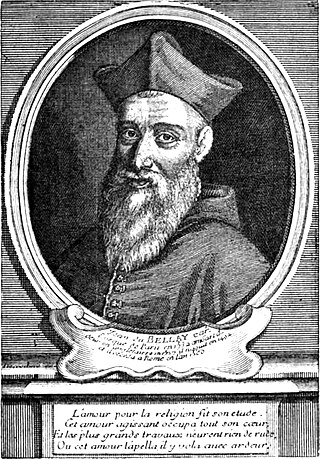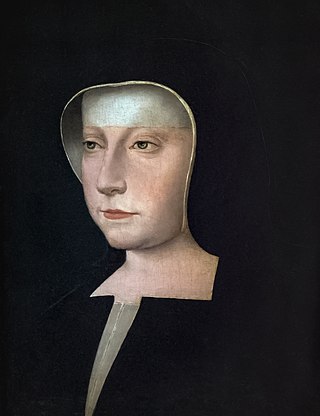
1617 (MDCXVII) was a common year starting on Sunday of the Gregorian calendar and a common year starting on Wednesday of the Julian calendar, the 1617th year of the Common Era (CE) and Anno Domini (AD) designations, the 617th year of the 2nd millennium, the 17th year of the 17th century, and the 8th year of the 1610s decade. As of the start of 1617, the Gregorian calendar was 10 days ahead of the Julian calendar, which remained in localized use until 1923.

Francis I was King of France from 1515 until his death in 1547. He was the son of Charles, Count of Angoulême, and Louise of Savoy. He succeeded his first cousin once removed and father-in-law Louis XII, who died without a legitimate son.

Jean du Bellay was a French diplomat and cardinal, a younger brother of Guillaume du Bellay, and cousin and patron of the poet Joachim du Bellay. He was bishop of Bayonne by 1526, member of the Conseil privé of King Francis I from 1530, and bishop of Paris from 1532. He became Bishop of Ostia and Dean of the College of Cardinals in 1555.

Louise of Savoy was a French noble and regent, Duchess suo jure of Auvergne and Bourbon, Duchess of Nemours and the mother of King Francis I and Marguerite of Navarre. She was politically active and served as the regent of France in 1515, in 1525–1526 and in 1529, during the absence of her son.

The House of Rohan is a Breton family of viscounts, later dukes and princes in the French nobility, coming from the locality of Rohan in Brittany. Their line descends from the viscounts of Porhoët and is said to trace back to the legendary Conan Meriadoc. Through the Porhoët family, the Rohans are related to the Dukes of Brittany, with whom the family intermingled again after its inception. During the Middle Ages, it was one of the most powerful families in the Duchy of Brittany. The Rohans developed ties with the French and English royal houses as well, and they played an important role in French and European history.

Jean-François Régis, SJ, commonly known as Saint John Francis Regis and Saint Regis, was a French priest of the Society of Jesus, recognized as a saint by the Catholic Church in 1737. A tireless preacher, Regis is best known for his work with at-risk women and orphans.

The Italian War of 1521–1526, sometimes known as the Four Years' War, was a part of the Italian Wars. The war pitted Francis I of France and the Republic of Venice against the Holy Roman Emperor Charles V, Henry VIII of England, and the Papal States. It arose from animosity over the election of Charles as Emperor in 1519–1520 and from Pope Leo X's need to ally with Charles against Martin Luther.

François-Emmanuel Guignard, comte de Saint-Priest, was a French politician and diplomat during the Ancien Régime and French Revolution.

Jean Le Veneur, son of a Norman baron, was a French Abbot, Bishop, Courtier, royal official, and Roman Catholic cardinal.

Créquy is a French noble family which originated in Artois.

The Magnate conspiracy was a plot among Croatian and Hungarian nobles to oust the Habsburg Monarchy from Croatia and Hungary, in response to the Treaty of Vasvár in 1664. This treaty – which ended the Fourth Austro-Turkish War – was highly unpopular in the Military Frontier, and those who were involved in the conspiracy intended to reopen hostilities with the Ottoman Empire after they broke away from Habsburg rule.
Plumeria is a genus of flowering plants whose common name is Frangipani.

Genlis is a French commune in the Côte-d'Or department. The 20th-century archaeologist Jean Charbonneaux (1895–1969) was born in Genlis.

The Franco-Ottoman alliance, also known as the Franco-Turkish alliance, was an alliance established in 1536 between Francis I, King of France and Suleiman I of the Ottoman Empire. The strategic and sometimes tactical alliance was one of the longest-lasting and most important foreign alliances of France, and was particularly influential during the Italian Wars. The Franco-Ottoman military alliance reached its peak with the Invasion of Corsica of 1553 during the reign of Henry II of France.

The siege of Corfu in 1537 was led by the Ottoman Emperor Suleiman the Magnificent, against the Republic of Venice-held island of Corfu. It is part of the Ottoman–Venetian War (1537–1540), one of the numerous Ottoman–Venetian Wars of the period.

Charles-Marie-François Olier, marquis de Nointel (1635—1685), a councillor to the Parlement of Paris, was the French ambassador to the Ottoman court of Mehmed IV, from 1670 to 1679, charged from the first with renegotiating the Capitulations under which French merchants and others did business within the Ottoman Empire.

François Savary de Brèves was a French ambassador of the 16th and 17th centuries as well as an Orientalist.

Louis Joseph de LorraineDuke of Guise and Duke of Angoulême, was the only son of Louis, Duke of Joyeuse and Marie Françoise de Valois, the only daughter of Louis-Emmanuel d'Angoulême, Count of Alès, Governor of Provence and son of Charles de Valois Duke of Angoulême, a bastard of Charles IX of France.

Two Studies of an Actor is the name given to a sheet of drawings in the trois crayons technique by the French Rococo artist Antoine Watteau. Dated between 1716 and 1721, the sheet was once in the collection of Watteau's friend, the manufacturer and publisher Jean de Jullienne; passing through a number of private collectors, it was acquired in 1874 by the Kupferstichkabinett, Berlin, where it remains.


















